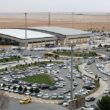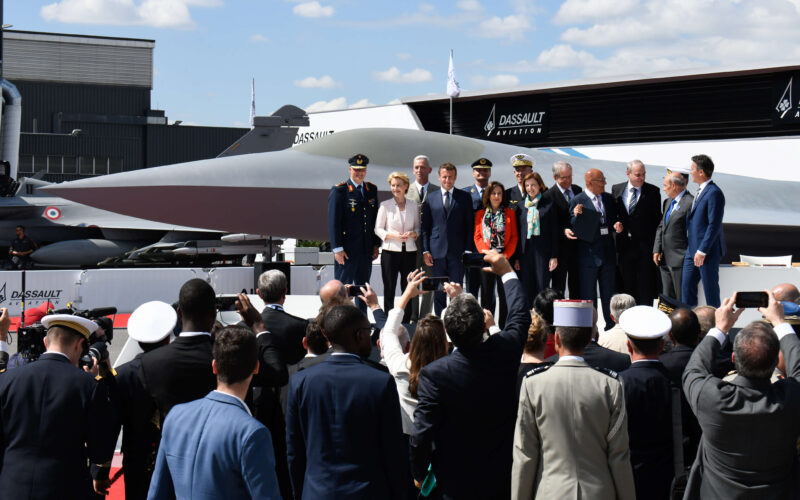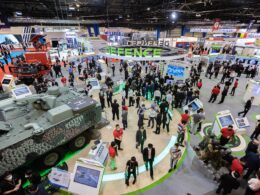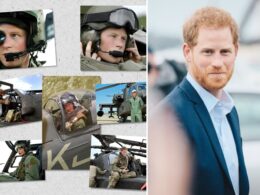A year after it was made official in ILA Berlin, the European fighter program unveiled itself a bit more during the Paris Air Show 2019.
A real size model of the Franco-Germany fighter developed by Dassault Aviation and Airbus, the Next Generation Fighter (NGF), was revealed on June 17, 2019, during the visit of French President Emmanuel Macron at the Paris Air Show.
While it is still an early design that is likely to change over the years of development, the model sports a V-tail, unlike the first concept presented during the Euronaval 2018 exhibition which had no vertical stabilizer at all and reminded in this regard of Dassault nEUROn experimental UCAV. Unlike the Rafale and the Typhoon, the lifesize model has no canard surface. It is overall slightly larger than a Rafale, which was expected.
Reveal New Generation Fighter pic.twitter.com/BzvnI5ntUg
— Dassault Aviation (@Dassault_OnAir) June 17, 2019
Following the presentation of the model, Florence Parly, Ursula von der Leyen and Margarita Robles, Defense ministers of France, Germany, and Spain respectively, signed an agreement that sets the legal framework for the joint development of a complete system of combat aircraft and drones.
After Germany and France officially launched the Future Air Combat System (FCAS) program during ILA Berlin in April 2018, the financial and industrial participation of Spain was confirmed in mid-February 2019 in a NATO meeting.
On the industrial side, Dassault and Airbus have submitted a joint industrial offer to the French and German governments for the Initial Demonstration Phase of the FCAS. Demonstrators of the FCAS technologies should be ready for an inaugural flight in 2026, according to Dassault.
Airbus and Dassault Aviation have already received a joint concept study (JCS) contract for €65 million from France and Germany on February 6, 2019. The study is aimed at merging the terms of the High Level Command Operational Requirement Document (HLCORD), signed by France and Germany during ILA Berlin 2018, with the two studies conducted separately by Airbus and Dassault since the beginning of the program.
“The Joint Concept Study awarded to Dassault Aviation and Airbus in January 2019 was the first step in a successful cooperation between the two companies,” said Eric Trappier, CEO of Dassault, during the Paris Air Show 2019.
The two engine manufacturers Safran and MTU Aero Engines also signed an industrial cooperation agreement for the motorization of the new-generation combat aircraft on February 6, 2019.
Strengthening the European defense autonomy
The NGF presented at the Paris Air Show 2019 is to play a central role in the FCAS, which will see the fighter jet cooperate with a swarm of support drones (Remote Carriers) within an Air Combat Cloud (ACC).
A first glimpse of the Remote Carriers was presented by the European developer and manufacturer of missiles MBDA on their stand. The RC-100 and RC-200, weighing respectively 100kg and 200kg, are presented as capable of participating in an operation by designating targets or scrambling the enemy defense systems, before hitting their target.
Come and see the armament and effector concepts that will lie at the heart of the next generation of European air combat systems. It’s on #MBDA static display!https://t.co/0l1GpWKRUy #PAS19 #avgeek #StrongerEurope #FutureOfEurope pic.twitter.com/jIOmqtn3Ns
— MBDA (@byMBDA) June 17, 2019
Another mockup of a Remote Carrier was presented by Airbus Defence and Space.
The new @AirbusDefence remote carrier mock-up on display at @salondubourget. Advertised by #Airbus as a modular and connected force multiplier and can be used for manned/ unmanned teaming. #PAS19 #AvGeek pic.twitter.com/gnvP4Qe9PX
— Khalem Chapman (@AirheadJourno) June 17, 2019
The FCAS should succeed to the Dassault Rafale and the Eurofighter Typhoon within the French, German, and Spanish air forces, and reinforce the European technological autonomy by creating a sixth generation fighter jet solution. It is set to enter service by 2040.









